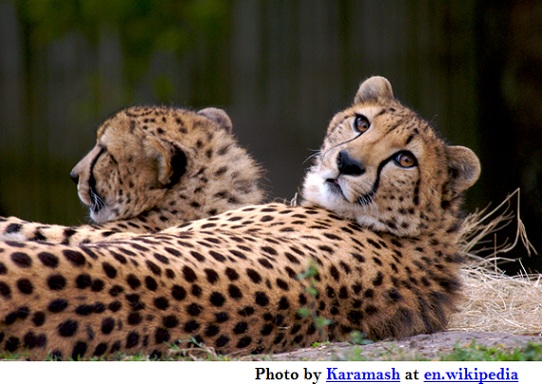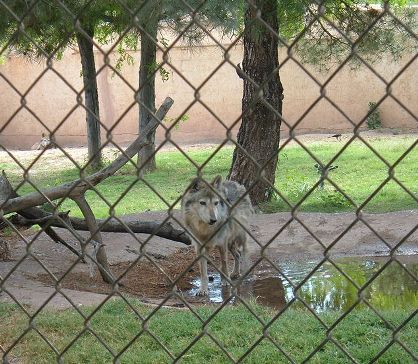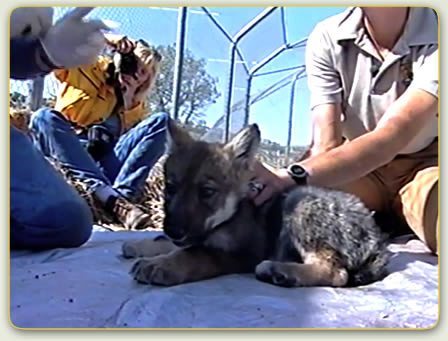In the Press: Date Night at the Zoo, if Rare Species Play Along
By Leslie Kaufman
 Note from Lobos of the Southwest: While the following article does not specifically address Mexican gray wolves, it is of interest to those of us who support the lobo’s recovery, because it explores the challenges and some of the shortcomings of captive breeding programs.
Note from Lobos of the Southwest: While the following article does not specifically address Mexican gray wolves, it is of interest to those of us who support the lobo’s recovery, because it explores the challenges and some of the shortcomings of captive breeding programs.
Without captive breeding, Mexican gray wolves would most likely be completely extinct now. They were nearly extinct until five wild Mexican wolves (four males and one pregnant female) were captured alive in Mexico from 1977 to 1980 and used to start a captive breeding program. (for more information, see Captive Breeding to the Rescue) Thanks to many dedicated people working in the Species Survival Program for the Mexican gray wolf, there are now approximately 307 Mexican wolves in 50 facilities. And although this article focuses primarily on cheetahs, many of the same issues arise with Mexican gray wolves. While captive animals can act as an “emergency population” for endangered species, long-term survival depends on viable populations in the wild.
FRONT ROYAL, Va. — After cautiously sniffing the grass, three male cheetahs at the animal-breeding center here suddenly began running in frenzied circles. It was a sign that a female cheetah that normally lives in the yard was in heat.
Then one of the males let out a low, seal-like bark — a signal for an even higher state of arousal. The other males were excused.
To maximize the chances for successful breeding, scientists have learned to separate cheetahs by gender, even preventing them from seeing each other before they mate. It turns out that familiarity can be a turnoff for cheetahs, too.
Finally, it was time to bring in the female. She seemed mystified by the male cheetah’s eagerness and failed to assume a mating position. The encounter fizzled.
With extinctions rising and habitats being destroyed, zoos are trying to breed about 160 endangered species in captivity. But while mating in the wild seems largely primal and effortless, in captivity it can be anything but.
Eighty-three percent of those species in North American zoos are not meeting the targets set for maintaining their genetic diversity, the Association of Zoos and Aquariums reports. In the case of cheetahs, fewer than 20 percent of those in North American zoos have been able to reproduce.
Zoos must figure out how to mate captive cheetahs and many other animals as so-called insurance populations, before their situation in the wild becomes untenable, said Jack Grisham, who has coordinated the association’s cheetah breeding plan http://www.cheetahssp.org/ for 20 years. But the disappointing success rate has led some field conservationists to question whether zoos should be in the breeding business. Many say they would prefer to see the money redirected to preserving wild habitats and species.
“I’d be happier about captive breeding if I thought it helped wild cheetahs,” said Luke Hunter, president of Panthera, a nonprofit group that works on global conservation efforts for big cats in the wild, including cheetahs. “Free of threats, they breed like rabbits in the wild. They don’t need supercostly assisted reproduction — they need a place to roam.” “¦
Cheetahs are much more finicky than, say, their big-cat cousins, lions and tigers, which reproduce with ease. But they are not nearly as difficult to breed as pandas, which have not produced a cub in captivity in the United States since 2010. “¦
Although they are not critically endangered, the world’s population of cheetahs has plummeted. At the turn of the 20th century, roughly 100,000 cheetahs roamed from Africa to the Mediterranean to India, according to the Smithsonian.
Today, Panthera and zoo association officials estimate that 7,000 to 10,000 remain in the wild as a result of habitat loss, poaching, and conflicts with farmers and ranchers.
Panthera promotes proven programs that help cheetahs survive alongside people. The group advises small livestock owners on how to prevent the marauding cats from devouring their animals, and it even donates trained guard dogs for the job. But no matter how aggressively conservation groups fight to preserve wild populations, Mr. Grisham said, the pressures are so great that zoo animals may someday have to serve as a genetic insurance bank.  ‘Noah Got It All Wrong’
‘Noah Got It All Wrong’
Breeding programs are not just about preserving species; they are about ensuring that zoos thrive, too. Until the 1970s, zoos could capture animals they wanted to exhibit. But a growing awareness of the vulnerability of many species led to treaties. And the Endangered Species Act of 1973 restricted imports of threatened animals, even by zoos.
So zoos began running coordinated breeding programs for threatened species. Then in 2000, the association opened a Population Management Center run by the Lincoln Park Zoo in Chicago to carry out detailed demographic and genetic analyses of breeding among animals, threatened or not, at 235 zoos. Staff members draft recommendations on how best to breed each of these populations.
In a closed population, as in zoos, the priority is high levels of genetic diversity to maintain a species’ adaptability and prevent inbreeding. The result is a kind of reverse natural selection, with the animals with the lowest rate of success vaulting to the top of the priority list because of the rareness of their genes.
Sarah Long, director of the Population Management Center in Chicago, said zoos started with too few animals of each species, and many do not have enough genetic variation to ensure their long-term survival in captivity. The median founding population for species at American zoos was around 15. Zoos now see the minimum number for larger mammals as 20.
“Noah got it all wrong,” Ms. Long said. “One or two or even a dozen of each species is not enough.”
The association runs nearly 600 cooperative breeding programs, but so far it has created formal breeding plans for only 357 species. About 55 percent of those with plans are considered imperiled in the wild by the International Union for Conservation of Nature, http://www.iucnredlist.org/ among them the western lowland gorilla and the scimitar-horned oryx.
Still, 40 percent of those 357 managed populations are dwindling — for some known and, in other cases, unknown reasons. “¦
Commercial animals like cattle are bred largely through artificial insemination. But researchers lack adequate knowledge on inseminating many exotic zoo animals.
So for now, most zoo animals mate the old-fashioned way, which presents its own logistical puzzles.
An institution may be reluctant to give up a popular chimp or penguin. Animals available from overseas can be blocked by agricultural treaties, diplomatic problems or quarantines.
 And animals, like humans, have their own ideas about their mates.
And animals, like humans, have their own ideas about their mates.
African penguins are generally monogamous. At the New England Aquarium, the birds are paired by keepers with an appropriate genetic match.
As they come of sexual age, the paired birds are then removed to a separate area to bond. But some 25 percent of the time the penguins refuse the designated suitor.
More Like the Wild “¦
For decades, zoos crowded all large cats into themed houses and treated them similarly. But their mating patterns can be radically different. For example, clouded leopards, a critically endangered species with less defined spots, pair up with their mates early in life. If they are introduced for mating as mature adults in captivity, it causes extreme stress, and the male will occasionally kill the female. Such attacks occurred repeatedly before researchers realized what the problem was.
Cheetahs, by contrast, do not pair off. Still, it was not until the 1990s that zookeepers understood that.
More recently, researchers have learned that fertile female cheetahs that are unrelated or have not been raised together should not be kept together because the nondominant female will experience so much stress that she stops going into heat.
To get around these problems for cheetahs and other animals, zoos are putting emphasis on conservation centers that are less like zoos and more like ranches or a safari park. The animal conservation center here has enough space to indulge the animals’ idiosyncrasies and mimic the wild.
The five centers that breed cheetahs now account for a disproportionate number of the victories, including an unusual case here in 2010.
A 5-year-old female cheetah had remained barren through many breeding attempts over two years. She had only a few prime years left, so a new male was trucked in from Florida, 900 miles away.
It worked. Born as a lone cub, the cheetah named Nick was removed from his mother’s care because of yet another research discovery: the cheetah alone among big cats will not produce enough milk for its baby if there is only one suckling. Anticipating that possibility, Dr. Crosier had timed another cheetah pregnancy to coincide with that of Nick’s mother.
As the center awaited the other birth, Nick was nursed with a bottle covered with cheetah fur so he would not grow too accustomed to humans. When the next birth — another singleton — took place, staff members waited until the new mother wandered off to eat and then placed Nick alongside the new baby, rubbing him with its bedding so he would absorb the smell.
When the mother returned, staff members held their breath: she could easily kill him with one snap of her jaws. Instead she adopted him and nursed both cubs. It was the sixth such transplant in American zoo history.
A few months ago, at 18 months, Nick was separated from his adoptive family. Dr. Crosier hopes he will soon breed.
“He has great genes,” she said proudly.
***************************************************************************
We appreciate all of the important, and often difficult, work the captive breeding facilities do to help Mexican gray wolves. We, and they, recognize that captive breeding is only one piece of the puzzle. The ultimate goal is to recover Mexican gray wolves in the wild where they belong. Although new releases of captive wolves into the wild are urgently needed to increase and strengthen the wild population, and there are many wolves eligible for release, the USFWS has not released any new wolves for over three and half years. Please write today and urge decision-makers to expedite the release of more wolves.
To read the full article published by the New York Times, click here.
Photo credits, Top to Bottom:
Cheetahs at the Houston Zoo courtesy of Karamash at en.wikipedia
Mexican gray wolf at the Alameda Park Zoo, courtesy of Allan S.
Biologists with Mexican wolf pup



